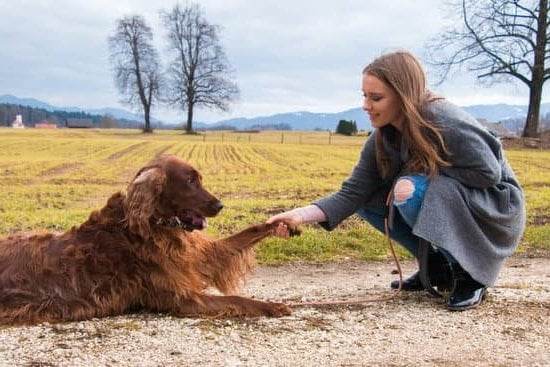Deafness in dogs presents a unique set of challenges when it comes to training, but with patience, understanding, and the right techniques, it is possible to successfully train a deaf dog. Many pet owners may wonder, “how do I train a deaf dog?” Understanding how deafness impacts communication and behavior in dogs is crucial in developing effective training strategies.
When it comes to training a deaf dog, traditional verbal cues will not be effective. Instead, visual cues and hand signals become essential tools for communicating commands and expectations. By learning to adjust your communication style to cater to your deaf dog’s needs, you can establish clear and effective ways to teach them obedience and new skills.
Building trust and a strong bond with your deaf dog is foundational in successful training. Trust-building exercises not only enhance the relationship between you and your furry companion but also create a secure environment where learning can take place. Through positive reinforcement techniques, consistent routines, and specialized training tools like vibration collars or light-up collars, you can navigate the challenges of training a deaf dog with confidence and compassion.
Adjusting Communication
Deaf dogs may face unique challenges when it comes to training due to their inability to hear commands or cues. However, with the right approach and techniques, training a deaf dog can be just as successful as training a hearing one. One of the key factors in effectively training a deaf dog is adjusting communication through visual cues and hand signals.
Understanding Visual Communication
Since verbal communication is not an option for deaf dogs, visual communication becomes essential. Using clear and consistent hand signals that are easy for your dog to understand is crucial. For example, using American Sign Language (ASL) signs for basic commands such as sit, stay, come, and lie down can help establish a solid foundation for training.
Creating Clear Hand Signals
It’s important to establish distinct hand signals for each command you want to teach your deaf dog. These signals should be easily distinguishable from one another to avoid confusion. Consistency is key when using hand signals, so make sure to use the same gestures every time you give a command. This will help your dog associate the signal with the desired behavior.
Patience and Practice
Training a deaf dog requires patience and practice. Since they rely solely on visual cues, it may take some time for them to understand and respond to commands consistently. Regular training sessions with plenty of positive reinforcement will help your deaf dog learn new behaviors and strengthen your bond. Remember that each dog learns at their own pace, so be patient and celebrate small successes along the way.
By adjusting your communication methods and incorporating visual cues and hand signals into your training routine, you can effectively teach your deaf dog new behaviors and commands. With dedication, consistency, and patience, you can build a strong bond with your furry companion while helping them thrive in their training journey.
Building Trust and Bond
Deaf dogs require a different approach to training compared to dogs with full hearing capabilities. One of the crucial aspects of effectively training a deaf dog is building trust and a strong bond. When a deaf dog trusts their owner, they are more likely to respond positively to training and feel secure in their environment. To establish this trust, it is essential to engage in activities that promote bonding and create a sense of security for the dog.
Bonding exercises can include spending quality time with your deaf dog through activities such as grooming, play sessions, and going on walks together. These interactions help strengthen the emotional connection between you and your canine companion, fostering a deeper bond built on trust and understanding. Additionally, incorporating training exercises into these bonding activities can further enhance the relationship between you and your deaf dog.
Trust-building exercises are also vital in the training process for deaf dogs. Start by establishing basic communication methods using visual cues and hand signals, ensuring consistency in your signals to avoid confusion.
Through positive reinforcement techniques such as treats, praise, or play rewards, you can reinforce desired behaviors and strengthen the trust between you and your deaf dog. With patience, consistency, and dedication to building trust, you can create a solid foundation for successful training sessions with your deaf canine companion.
| Aspect | Importance |
|---|---|
| Bonding Exercises | Promotes emotional connection and trust between owner and deaf dog |
| Trust-Building Exercises | Establishes effective communication methods and reinforces positive behaviors |
Positive Reinforcement Techniques
Training a deaf dog requires a different approach compared to training hearing dogs. One of the most effective methods for training deaf dogs is through positive reinforcement techniques. Positive reinforcement involves rewarding your dog with treats, praise, or play when they exhibit desired behaviors. This method helps create a strong bond between you and your dog while also motivating them to learn and follow commands.
When using positive reinforcement with a deaf dog, it’s essential to find out what motivates them. Some deaf dogs may be food-motivated, while others may respond better to toys or affection. By understanding what rewards your dog values the most, you can tailor your training sessions to be more effective and enjoyable for your furry friend.
In addition to rewards, timing is crucial when using positive reinforcement with a deaf dog. Since they cannot hear verbal cues or commands, you must use visual signals or hand gestures to communicate effectively. Be consistent in your signals and always reward your dog immediately after they perform the desired behavior. This will help them understand what you expect from them and reinforce their learning effectively.
Specialized Training Tools
Deaf dogs require specialized training tools to aid in their learning process, as traditional auditory cues may not be effective. These tools can help bridge the communication gap and make training more successful. One of the most commonly used tools for training deaf dogs is vibration collars.
Vibration collars work by emitting a gentle vibration that the dog can feel, serving as a tactile cue for commands. This allows you to get your deaf dog’s attention and communicate with them effectively during training sessions.
In addition to vibration collars, light-up collars can also be a helpful tool for training deaf dogs. Light-up collars are designed with LED lights that flash or change color, providing a visual cue to grab the dog’s attention.
This can be especially useful in low-light conditions or when you need to signal commands from a distance. By incorporating these specialized training tools into your training routine, you can enhance your deaf dog’s learning experience and ensure they understand what is expected of them.
When using vibration collars and light-up collars for training deaf dogs, it is important to introduce these tools gradually and associate them with positive experiences. Begin by pairing the collar with treats or rewards to create a positive association.
Use consistent hand signals or visual cues along with the tools to reinforce commands and help your deaf dog understand what behavior is expected of them. With patience, consistency, and the right tools, you can effectively train a deaf dog and strengthen your bond with them through clear communication methods.
By incorporating specialized training tools like vibration collars and light-up collars into your training routine for a deaf dog, you are setting them up for success in learning new commands and behaviors. These tools not only help improve communication but also make the training process more engaging for both you and your pet.
Remember that every deaf dog is unique, so it may take some trial and error to find the right combination of tools and techniques that work best for your furry companion while keeping their safety and well-being as top priorities throughout the entire training process.
Consistency Is Key
Deaf dogs require consistency in their training routines and commands to ensure successful learning and behavioral development. Consistency not only helps the dog understand what is expected of them, but it also reinforces the communication between the owner and the dog. With consistent training, deaf dogs can learn to follow cues, commands, and instructions effectively.
Establishing Clear Communication
Consistency in training routines helps in establishing clear communication with a deaf dog. Using visual cues and hand signals consistently for commands enables the dog to associate specific gestures with desired behaviors. It is essential to stick to a set of consistent signals for each command to avoid confusion and facilitate quick learning. By being consistent in your communication approach, you are helping your deaf dog understand what is expected from them, fostering a stronger bond between you both.
Repetition and Practice
Consistent repetition and practice of training exercises are crucial for deaf dogs to grasp commands and behaviors effectively. Practicing daily routines or commands in various environments can help reinforce their understanding and responsiveness. Repetition not only solidifies their learning but also enhances their confidence as they become more familiar with the cues given. Regular training sessions should be part of the daily routine to maintain consistency and continuous improvement in the obedience of a deaf dog.
Setting Clear Rules
Consistency in setting clear rules and boundaries is vital when training a deaf dog. Establishing consistent guidelines about behavior expectations, rewards, and consequences helps the dog understand what is acceptable or unacceptable. By maintaining firm but fair rules consistently, you are providing structure and guidance for your deaf dog, which can contribute to their overall well-being and improved behavior. Consistency in enforcing rules creates a stable environment for your pet to thrive in during the training process.
Safety Measures
Deaf dogs require special attention to ensure their safety during training sessions and in their everyday life. Just like any other dog, they can be curious and easily distracted, but their inability to hear commands or warnings makes them more vulnerable in certain situations. To address this, it is essential for pet owners to take extra precautions to keep their deaf dog safe at all times.
One important safety measure for training a deaf dog is using visual cues and hand signals effectively. Creating clear and consistent signals that your dog can easily understand will help prevent misunderstandings and potential accidents. Additionally, keeping your deaf dog on a leash or in a secure area during training sessions can prevent them from wandering off or getting into dangerous situations unnoticed.
Another crucial aspect of ensuring the safety of a deaf dog is providing them with proper identification. In case they accidentally get separated from you, having identification tags with contact information and possibly even microchipping your dog can greatly increase the chances of a safe return. It is also recommended to teach your deaf dog specific recall signals so that they can come back to you reliably when called, further enhancing their safety both indoors and outdoors.
Overall, prioritizing the safety of your deaf dog should be a top priority when training and caring for them. By incorporating clear communication methods, utilizing proper identification measures, and maintaining vigilant supervision, pet owners can create a safe environment where their deaf dogs can thrive confidently. Remember that patience, consistency, and precaution are key elements in keeping your furry companion safe and happy in all aspects of their life.
Overcoming Challenges
Training a deaf dog comes with its own set of challenges, but with patience and the right approach, these challenges can be overcome effectively. One common challenge when training a deaf dog is the inability to get their attention through verbal cues. Without the ability to hear commands, it can be challenging to grab their focus during training sessions. However, there are strategies that can be implemented to tackle this issue.
To address the challenge of grabbing a deaf dog’s attention, it is essential to rely on visual cues and hand signals. Incorporating consistent hand signals for various commands will help your deaf dog understand what is expected of them. Using bright and contrasting colors for hand signals can also make them more visible to your furry friend. Additionally, using treats or rewards immediately after giving a hand signal will reinforce the connection between the signal and the desired behavior.
Another common challenge in training a deaf dog is maintaining their focus during training sessions. Deaf dogs may easily become distracted by their surroundings, making it harder to keep them engaged in the training process. To overcome this challenge, establish a quiet and distraction-free environment for training sessions.
It is also important to keep training sessions short and engaging to prevent your deaf dog from becoming bored or frustrated. By incorporating fun activities and interactive games into training sessions, you can keep your deaf dog interested and focused on learning new commands.
Celebrating Success
Training a deaf dog requires patience, understanding, and dedication. Celebrating the milestones and successes in their training journey is not only important for boosting their confidence but also for strengthening the bond between you and your furry companion. But the question remains, “How do I train a deaf dog?” The key lies in adapting your training methods to accommodate their unique needs.
One of the most crucial aspects of training a deaf dog is using positive reinforcement techniques. Celebrating even small achievements with treats, praise, or playtime can go a long way in motivating them to continue learning. This positive approach not only helps in shaping their behavior but also fosters a strong connection based on trust and mutual respect.
In addition to rewards, consistency in training routines and commands is vital for a deaf dog’s progress. By establishing clear and consistent signals through visual cues or hand signals, you provide them with a reliable communication method. Consistency helps them understand what is expected of them, leading to more successful training sessions.
Remember, celebrating success is not just about the end goal but also about acknowledging the effort and progress made along the way. By doing so, you are not only building your deaf dog’s confidence but also creating a harmonious training environment based on positivity and encouragement.
Frequently Asked Questions
Are Deaf Dogs Harder to Train?
Deaf dogs are not necessarily harder to train compared to hearing dogs. The key is to use visual cues and hand signals instead of verbal commands. Patience, consistency, and positive reinforcement are crucial in training a deaf dog.
How Do You Discipline a Deaf Dog?
Discipline for a deaf dog involves alternative methods since traditional techniques like verbal commands or noises are ineffective. Using gentle touches, visual cues, and redirecting behavior with positive reinforcement can effectively communicate boundaries and expectations to a deaf dog.
How Do You Get a Deaf Dog Attention?
Getting a deaf dog’s attention requires using vibrations or subtle touches to signal them. Some owners also resort to using specialized vibrating collars or light signals to alert their deaf dogs. Establishing strong bond through consistent training and communication will help maintain attention from the deaf dog.

Welcome to the blog! I am a professional dog trainer and have been working with dogs for many years. In this blog, I will be discussing various topics related to dog training, including tips, tricks, and advice. I hope you find this information helpful and informative. Thanks for reading!





